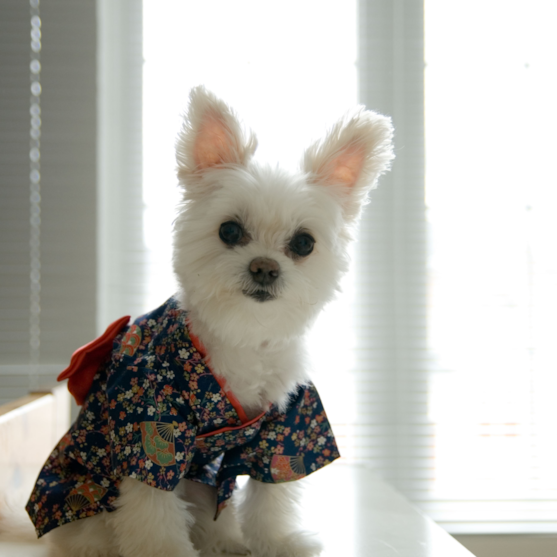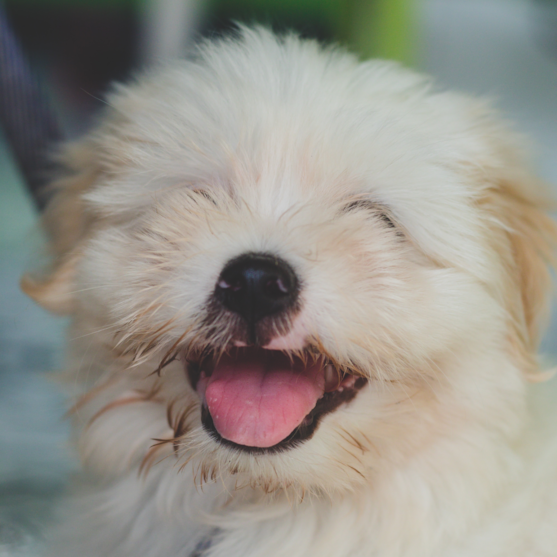Maltipom Breed Information


The Maltipom is a cheerful, compact companion that blends the affectionate sweetness of the Maltese with the spunky charm of the Pomeranian. As a cross between two beloved toy breeds, the Maltipom brings together everything people love about small dogs: warmth, playfulness, and a personality that’s far bigger than its size.
Light on their feet and full of heart, these dogs were bred for companionship. Whether they’re tucked into your arm on a walk, curled up in your lap at home, or trotting proudly beside you with a spring in their step, Maltipoms are happiest when they’re close to their people. That emotional closeness is part of what makes them such a popular designer toy breed.
Their small size makes them a natural fit for apartments, condos, or homes without large yards. But don’t let their frame fool you—Maltipoms carry an alert, lively spirit. They’re expressive, fast to learn routines, and quick to pick up on your mood. Their coat, which can range from soft waves to fluffy poofs, adds to their charm and gives each dog a one-of-a-kind look.
As a Maltese Pomeranian mix, this breed offers a balance of calm and confidence. They’re loyal but social, active but easy to manage, and full of character in a size that fits just about any lifestyle.
Characteristics
- Loyal to the core – Maltipoms form close bonds with their people and prefer to stay nearby, whether that means resting at your feet or shadowing you around the house.
- Bold and curious – While their size keeps them on the smaller side, their attitude doesn’t. They often carry themselves with the quiet confidence that comes from their Pomeranian lineage.
- Gentle at home – These dogs love being touched, held, and included. Whether it’s a quiet morning or a busy day, they adapt easily as long as they’re part of the action.
- Expressive eyes and alert ears – The Maltipom temperament is easy to read thanks to their animated expressions. They often “communicate” with a tilt of the head or a soft bark when they need attention.
- Small, but not fragile – Most Maltipoms weigh between 5 and 10 pounds, making them easy to carry and care for. But they’re well-balanced and agile, not overly delicate.
- Low-shedding with variable coats – Their fur can be straight and silky or slightly fluffy, often reflecting a perfect blend of both parent breeds. Either way, grooming is part of the routine.
- Naturally alert – These dogs are quick to notice changes in their environment and may bark when someone’s at the door. Still, they usually calm down once they know everything’s fine.
- Eager to learn – With consistent training and positive reinforcement, the Maltipom picks up commands quickly. They’re sharp, responsive, and always tuned in.
- Charming and social – A well-socialized Maltipom tends to greet visitors with curiosity, not caution. They’re polite, playful, and great at adapting to new faces and places.

Appearance
The Maltipom is a petite and eye-catching hybrid, often drawing attention for its plush coat and expressive face. As a Maltese Pomeranian mix, this breed brings together the best of both parents—delicate features from the Maltese, and a bold presence from the Pomeranian.
Weighing between 5 and 10 pounds, and standing about 8 to 11 inches tall, the Maltipom fits easily into the toy breedcategory. Their body is compact but balanced, with a graceful build that reflects both agility and softness. They move with confidence, often with a bounce in their step and a tail curled gently over their back.
The coat can vary in texture, depending on which parent they take after more closely. Some have the long, straight, silky hair of the Maltese, while others inherit the fluffier, double-layered coat of the Pomeranian. Most fall somewhere in between, with a soft, medium-length coat that gives them a plush, cloudlike appearance.
Coat colors include white, cream, tan, apricot, sable, or combinations of these. Some have markings or shaded ears that add even more character to their look. No two Maltipoms are exactly alike, which is part of their charm.
Their eyes are typically dark, round, and full of expression—always alert, often curious. Ears may stand upright like a Pomeranian’s or drop softly to the side like a Maltese’s. Their muzzle is short and tidy, giving the face a gentle, welcoming shape.
Altogether, the Maltipom coat and appearance give off a blend of elegance and spunk. Whether clipped short for easy care or kept fluffy for maximum charm, they’re the kind of dog that gets noticed—and remembered.
Temperament
The Maltipom temperament is a blend of gentle devotion and spirited charm. This hybrid draws from the emotional intelligence of the Maltese and the confident sparkle of the Pomeranian—two breeds known for thriving in human-centered households. The result is a dog that feels present, affectionate, and just the right amount of bold.
This is a companion dog personality at its finest. Maltipoms love to be close, whether they’re curled up on the couch beside you or waiting by the door to follow you on your next errand. They form strong bonds with their families and often grow particularly attached to one person, though they’re generally friendly with everyone they trust.
Their size may be small, but their personality fills the room. Most Maltipoms are playful, animated, and not shy about expressing themselves. They’ll use a look, a little bark, or a tail wag to let you know exactly what they’re thinking. They enjoy attention, thrive on affection, and don’t like being ignored—especially for too long.
At the same time, they’re sensitive and emotionally in tune. Changes in tone or environment often affect them, which is why consistency and gentle routines work so well. They’re not high-strung, but they can become nervous or vocal if their needs for connection and interaction aren’t being met.
Because of their social nature, Maltese Pomeranian mix behavior tends to shine in homes where someone is around most of the day. They’re not fans of being left alone for long stretches, and they can become vocal if bored or lonely. But when their social needs are met, they’re calm, well-mannered, and endlessly loyal.
They also tend to get along well with other pets and respectful children, especially when raised alongside them or properly socialized. Their warmth, emotional awareness, and fun-loving spirit make them an ideal companion for just about any home that values closeness.
Care
Grooming
The Maltipom may be small, but their coat often brings big grooming responsibilities—especially if you’re aiming to keep that signature soft, fluffy look. Whether their hair leans more toward the silky strands of the Maltese or the dense fluff of the Pomeranian, regular upkeep is a must.
Most Maltipoms do best with brushing three to four times a week, though some may need daily attention if their coat is long or prone to tangles. A slicker brush or metal comb helps keep things smooth, especially behind the ears, under the legs, and around the tail—common trouble spots where mats can sneak in quickly.
For many owners, a professional trim every six to eight weeks helps make life easier. A shorter, manageable cut keeps the coat looking neat and cuts down on maintenance at home. Popular styles include the teddy bear or puppy cut, both of which keep that signature Maltipom charm while trimming grooming time in half.
As a low-shedding dog, the Maltipom produces minimal loose fur around the house. However, they’re not maintenance-free. Their hair grows continuously, so even though they don’t shed much, they still need routine brushing, bathing, and trimming to stay clean and comfortable.
Bathing every three to four weeks is usually enough, though active dogs or those with skin sensitivities may need a gentler schedule. Use a dog-friendly shampoo that suits their skin type—some Maltipoms can be prone to dryness or itching without the right product.
Coat maintenance for small breeds also includes ear care, especially for dogs with drop ears. Weekly cleaning with a vet-approved solution keeps moisture and debris from causing infections. And like all small breeds, the Maltipom benefits from regular dental care. Brushing several times a week, plus vet-approved dental treats or water additives, helps maintain long-term oral health.
Finally, nail trims every few weeks help keep them steady on their feet. If you can hear the clicking on tile or wood floors, it’s time for a trim.
Exercise Needs
The Maltipom doesn’t need intense workouts to stay balanced, but they do need steady movement and meaningful interaction throughout the day. As a cross between two lively breeds, the Maltipom exercise needs fall into the moderate range—enough to keep their minds engaged and their bodies limber, without ever becoming overwhelming.
For most dogs in this mix, 30 to 45 minutes of activity per day is ideal. That might look like two short walks, a little playtime inside, and a few mental games sprinkled in. They’re active, but not hyper. And they’re smart enough to get bored if they don’t have something to do.
Their compact size means they adapt well to apartment living, as long as they’re included in daily routines. A quick trot around the block or some time exploring the backyard goes a long way. But even in smaller spaces, a game of fetch down the hallway or hide-and-seek with toys can meet much of their daily activity for small dogs.
Mental stimulation is just as important as physical movement. The Maltipom loves puzzles, simple tricks, and interaction. Training sessions, food-dispensing toys, or even supervised people-watching by a window can keep them content. When their brains are busy, they’re far less likely to bark or develop anxious habits.
While this toy breed energy level doesn’t demand much, consistency matters. Skipping activity for several days in a row can lead to restlessness or boredom-related behavior. But when they’re given regular outlets and included in daily rhythms, Maltipoms stay calm, happy, and easy to live with.
They also love to match your pace. On active days, they’re ready to tag along. On quiet days, they’ll happily curl up and relax—just as long as they’re close to you. That adaptability makes them a great fit for many lifestyles.
Health
The Maltipom is generally a healthy little dog, especially when bred responsibly and raised with consistent care. Drawing from two well-established breeds, they tend to benefit from a mix of resilience and vitality. Still, like all dogs, they have a few health concerns that owners should stay aware of.
Some of the more common Maltipom health issues include dental disease, allergies, and mild orthopedic conditions. As a small breed, they’re especially prone to plaque buildup and gum sensitivity. Brushing their teeth several times a week and scheduling regular dental checkups goes a long way in protecting long-term wellness.
Allergies—whether food-related or environmental—can also be a concern. These may show up as itchy skin, ear infections, or digestive upset. Most cases are manageable with dietary adjustments or vet-recommended treatments, and early attention usually prevents long-term discomfort.
Joint concerns like patellar luxation (a kneecap that slips out of place) may also appear in some dogs. In many cases, it’s mild and requires only monitoring or light activity modifications. Keeping your Maltipom at a healthy weight is one of the best ways to protect their joints and mobility.
Because of their compact snouts, some Maltipoms may experience minor respiratory issues—especially if they take after the Pomeranian parent. Monitoring for signs of heavy breathing, especially in hot weather or during play, helps you catch problems early.
Routine preventive care for Maltipoms makes all the difference. This includes annual vet checkups, vaccinations, parasite prevention, and bloodwork as they age. Staying ahead of problems is far easier than reacting to them later.
Lifespan
The Maltipom is a long-living companion, with most dogs enjoying a lifespan of 12 to 15 years—and sometimes even longer with attentive care. As a hybrid of two sturdy toy breeds, the Maltipom inherits a strong foundation for wellness and often ages gracefully when raised in a stable, loving environment.
Being a long-living small breed, their longevity is supported by steady routines, good nutrition, and regular vet care. Many Maltipoms stay energetic well into their senior years, maintaining their curiosity, playfulness, and attachment to their people. While they may slow down physically, their emotional connection rarely fades.
As they age, some small changes make a big difference. Softer bedding, easier access to favorite napping spots, and shorter walks help keep them comfortable. Senior care for toy dogs also includes more frequent health checks, since early detection of small issues can prevent larger problems down the line.
One of the keys to supporting the Maltipom lifespan is maintaining a healthy weight. Extra pounds can stress the joints and increase the risk of heart disease or diabetes—conditions that are manageable but easier to avoid than to treat. A balanced diet, consistent exercise, and measured portions help keep them light on their feet.
Emotionally, aging Maltipoms often become even more attached to their people. They enjoy routines, familiar voices, and calm environments where they feel safe. Providing gentle stimulation—like soft toys, quiet walks, or peaceful lap time—helps keep their spirit engaged.
Training
The Maltipom is a smart, eager little dog with a surprising ability to pick up new routines quickly—especially when the training process is positive and consistent. With the intelligence of the Maltese and the alert nature of the Pomeranian, this mix is well-suited to learning basic commands, household manners, and even a few fun tricks.
Because of their size and sensitivity, Maltipom training is most successful when it leans into encouragement rather than correction. Praise, treats, and repetition help reinforce good behavior without overwhelming them. Their emotional awareness makes them responsive to tone, so a calm voice and light structure go a long way.
Start early if you can. Young Maltipoms are curious and open to learning, but even older dogs adapt well with time and patience. Obedience for small dogs doesn’t need to be formal—it’s more about consistency. Teaching simple cues like “sit,” “stay,” and “come” helps create boundaries and builds trust.
House training may require some extra effort, as smaller breeds can take a bit longer to develop strong bladder control. Crate training, scheduled potty breaks, and lots of praise for outdoor success help build lasting habits. Stay consistent, and avoid punishment—these dogs want to please, even if they don’t always get it right on the first try.
Socialization is just as important as obedience. Because of their size and alertness, Maltipoms may become anxious or reactive if they’re not exposed to new people, places, and sounds early on. Calm introductions help them feel more confident and relaxed, both at home and in public.
Mental stimulation matters, too. Like many toy breeds, the Maltipom thrives when challenged with small tasks or games. Puzzle toys, trick training, and problem-solving exercises help them stay sharp and content. A bored Maltipom is more likely to bark or become clingy—keeping their mind engaged helps prevent that.
History
The Maltipom is part of the growing wave of modern designer dog breeds—intentional crossbreeds developed to combine the most desirable qualities of two purebreds. In this case, the Maltipom blends the affectionate nature of the Maltese with the bold, spirited energy of the Pomeranian. While the exact date of origin is unclear, the breed began gaining traction in the United States in the early 2000s, during a period when small, family-oriented hybrids started drawing widespread attention.
Unlike older breeds with centuries of recorded history, the Maltipom history is still being written. It wasn’t developed for a specific job or working role, but for companionship—bringing together two breeds already cherished for their people-centered personalities, compact size, and charm.
To understand the Maltese Pomeranian mix origin, it helps to look at the two parent breeds. The Maltese is an ancient toy breed, dating back thousands of years, with documented roots in the Mediterranean region. These dogs were bred purely for companionship and were favored by royalty and nobility across Europe for their elegance and affectionate nature.
The Pomeranian, while also a companion breed today, originally descended from larger sled-pulling dogs in the Arctic. Over centuries, it was bred down in size and became popular in European courts—most notably in England, where Queen Victoria famously helped shape the breed’s modern look and size. Pomeranians are confident, lively, and deeply attached to their families.
By combining these two breeds, breeders aimed to create a dog that was emotionally responsive, small enough for urban living, and stylish without being overly delicate. The result was the Maltipom—a dog that offers a blend of calm affection and playful energy, all wrapped in a soft, low-shedding coat.
Today, the Maltipom is not officially recognized by major kennel clubs like the AKC, but it is listed by hybrid and designer dog registries. As its popularity grows, so does the understanding of what makes this crossbreed so appealing: adaptability, emotional warmth, and a timeless charm that fits almost any lifestyle.
